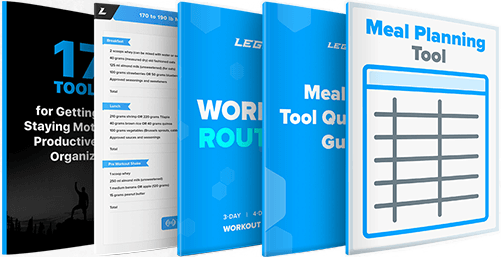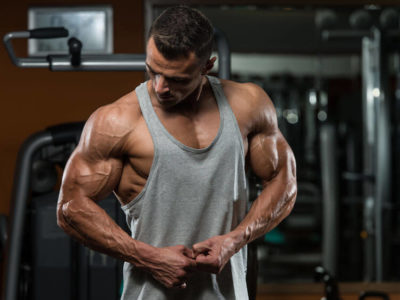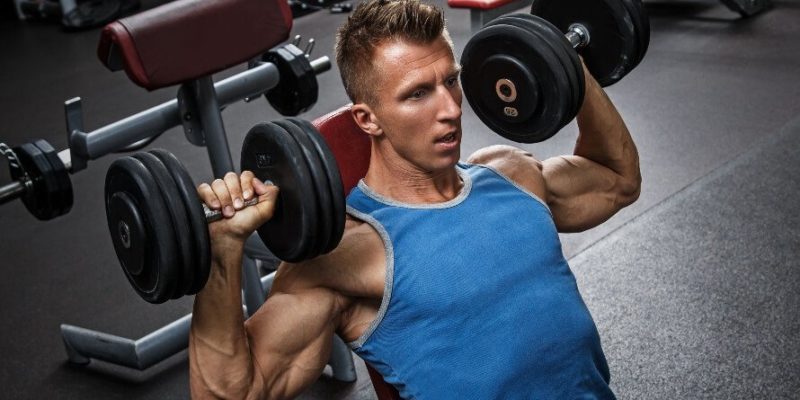
If you want a great upper body, you need great shoulders. Them’s just the breaks.
Problem is, most people find that their deltoids (the muscles that make up your shoulders) are stubborn sons of guns that take their sweet time to grow.
That’s why it’s important to choose shoulder exercises that train your delts effectively, like the dumbbell shoulder press.
This exercise is excellent at training the front and side deltoids, which are most responsible for the size and shape of your shoulders, and it’s also safe, easy to learn, and requires minimal equipment.
So, if you want to learn how to do the standing and seated dumbbell shoulder press and its close cousin, the Arnold shoulder press, this article is for you.
In it, you’ll learn what the dumbbell shoulder press is, what muscles it works, how to do it with proper form, what the most common mistakes are and how to fix them, and the best dumbbell shoulder press variations.
What Is a Dumbbell Shoulder Press?
The dumbbell shoulder press—also known as the DB shoulder press—is an exercise that involves pressing weights vertically overhead. It works the same way as the overhead shoulder press except you use dumbbells instead of a barbell.
The dumbbell shoulder press can be performed seated or standing, though most people find they can lift more weight when they perform it seated.
There are two reasons for this:
- Getting the dumbbells into position to do the standing dumbbell shoulder press can be difficult (and nearly impossible if they’re heavy), which wastes energy.
- The standing dumbbell shoulder press requires more balance and coordination because you don’t have a backrest to use for support.
Thus, I typically recommend the seated dumbbell shoulder press over the standing version, but both are viable exercises.
Dumbbell Shoulder Press: Muscles Worked
Although the dumbbell shoulder press is primarily thought of as a shoulder exercise, it actually trains far more than that.
Specifically, the main muscles worked by the dumbbell shoulder press are the . . .
. . . and it also stimulates the abs, biceps, forearms and serratus anterior to a lesser degree, too.
Here’s a graphic showing the main muscles involved in the exercise:
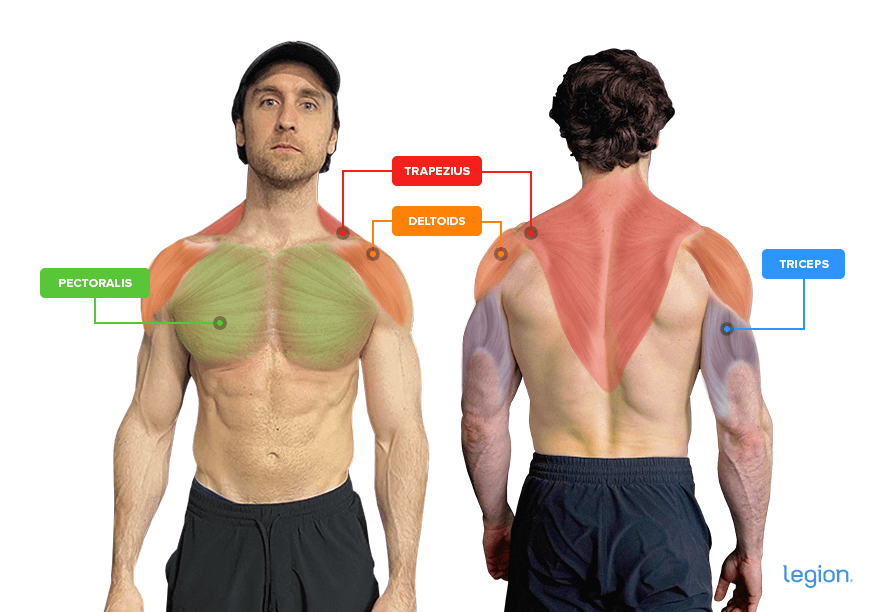
Interestingly, research shows that you can increase the amount of work your shoulder muscles do by performing the exercise standing rather than seated.
However, as we’ve already seen, you probably won’t be able to lift as much weight when you do the exercise standing, which limits the amount you can overload your muscles and likely negates any muscle-building benefit you gain from doing the standing shoulder press.
Given that the seated dumbbell shoulder press is more comfortable, easier to learn, set up, and perform, and allows you to lift more weight than the standing dumbbell press, I recommend sticking to the seated dumbbell shoulder press whenever possible.
How to Do the Seated Dumbbell Shoulder Press
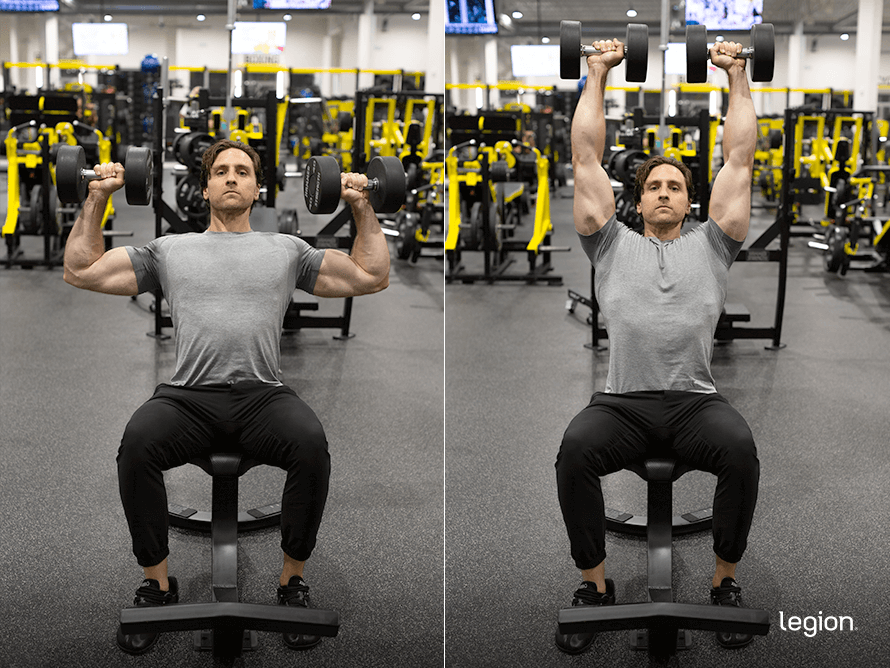
If you want to build muscle, gain strength, and stay injury-free, learning proper seated dumbbell shoulder press form is key.
The best way to do this is to break the exercise up into three phases: set up, press, descend.
Step #1: Set Up
While sitting on an upright bench, hold a dumbbell in each hand and rest them on your thighs. Hoist the dumbbells up so you’re holding them just above your shoulders with your palms facing away from you by giving them a nudge with your thighs.
Drive your feet into the floor so that your mid and upper back is pressed against the backrest, push your chest out, and pull your shoulder blades down and together (a good cue for this is to think of pulling your shoulder blades into your back pockets).
Step #2: Press
Push the dumbbell toward the ceiling until your elbows are almost locked. The dumbbells should naturally drift toward each other as your elbows straighten, but shouldn’t slam together above your head.
Remember to keep your shoulder blades “down and back” and your feet on the floor. Keep your mid and upper back pressed into the backrest, and avoid excessively arching your lower back or letting your butt scoot forward on the bench.
Step #3: Descend
Lower the dumbbells until they’re just above your shoulders (the handles should almost line up with your ears) to return to the starting position.
Seated Dumbbell Shoulder Press Form: Common Mistakes
1. Pressing one arm higher than the other.
The problem: Because most people are stronger on one side of their body than the other, many people find that they struggle to fully straighten their weaker arm (the left, for right-handed people, and vice versa).
The fix: Choose dumbbells that are light enough for you to complete full reps with your weaker side. They may feel too light for your stronger side, but over time your weaker side will catch up to your stronger side so that you can straighten both arms equally.
2. Slamming the dumbbells together.
The problem: As you press the dumbbells overhead your hands will naturally drift closer together. However, some people exaggerate this movement and slam the dumbbells together at the top of each rep, which can throw off your balance and make the exercise more difficult to control (and make you look like a dip in the gym).
The fix: Think about “throwing the dumbbells into the ceiling.” Not only will this cue help you lift more weight, it’ll help you to focus on pressing the dumbbells straight up, which will prevent them from smacking into one another.
3. Not using a full range of motion.
The problem: As you progress to heavier weights, you may feel tempted to cheat by shortening the range of motion—only lowering the dumbbells to about eye level. While this makes it easier to press heavier weights, it also makes the exercise less effective.
The fix: The main reason people fail to use a full range of motion is they try to lift weights that are too heavy. Instead, use weights that allow you to complete full reps before progressing. Give your body time to grow bigger and stronger, and don’t rush the process by compromising your technique.
Seated Dumbbell Shoulder Press Variations and Alternatives
1. Arnold Shoulder Press
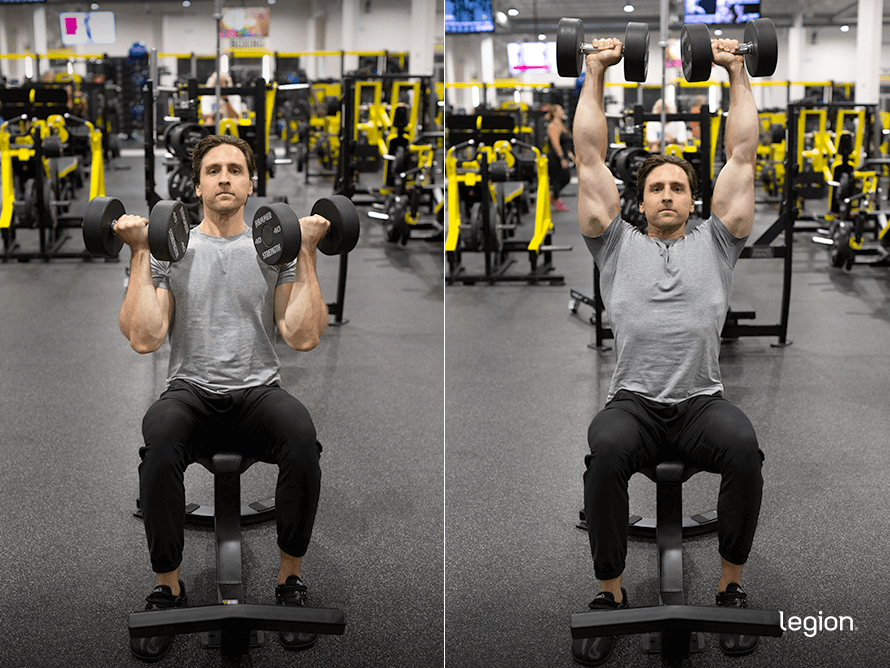
Why: Most overhead pressing exercises emphasize the anterior deltoid (front part of the shoulder), but because of the way you rotate your wrists in the Arnold press, you shift some of the emphasis to the side delts, helping you develop more proportional shoulders.
How to:
- While sitting on an upright bench, hold a dumbbell in each hand and rest them on your thighs.
- Nudge the dumbbells upward with your thighs and hoist them up so you’re holding them just in front of your shoulders with your palms facing toward you.
- Press the dumbbells straight up over your head while rotating your wrists until your arms are straight, your elbows are locked, and your palms are facing away from you.
- Reverse the movement and return to the starting position.
2. Seated Barbell Shoulder Press
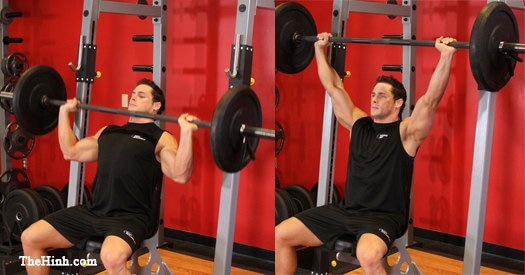
Why: Using a barbell instead of dumbbells for the seated shoulder press enables most people to press about 10 to 20% more weight and progress to heavier weights faster, which is great for building muscle and strength. The downsides are that it has a shorter range of motion and it doesn’t help you find and fix muscle imbalances.
How to:
- Set up an upright bench in a squat rack or power rack, or use a seated barbell press station.
- Sit in the seat and press your back against the bench, reach your arms overhead, and take a note of the height of your wrists in relation to the rack—this is the height you should set the barbell on the hooks.
- Set the barbell on the hooks, sit down, and grip the bar with a shoulder-width grip and your palms facing away from you.
- Unrack the barbell and lower it to your collarbone.
- Once the bar reaches your collarbone, press the bar toward the ceiling and return to the starting position.
3. Standing Barbell Shoulder Press
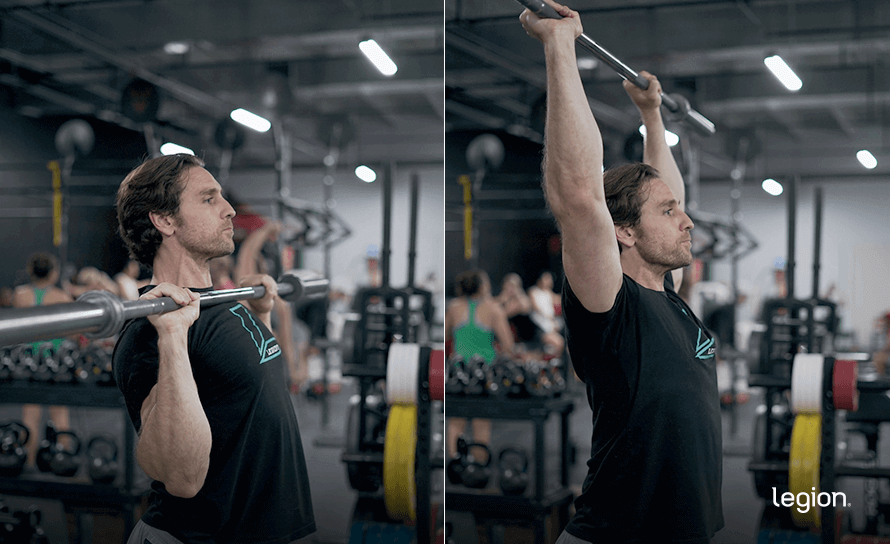
Why: In addition to improving upper body strength and shoulder, trap, triceps, and upper chest size, the barbell overhead press develops your whole-body balance and coordination.
How to:
- Set a barbell in a rack at the same height as your upper chest.
- Grip the bar with a shoulder-width grip and your palms facing away from you.
- Unrack the barbell and take a small step backwards with each foot, keeping your forearms vertical, and your elbows tucked close to your sides.
- Plant your feet just outside of shoulder-width, brace your core, squeeze your glutes, and push the bar toward the ceiling.
- Once your arms are straight, reverse the movement and return to the starting position.
4. Shoulder Press Machine
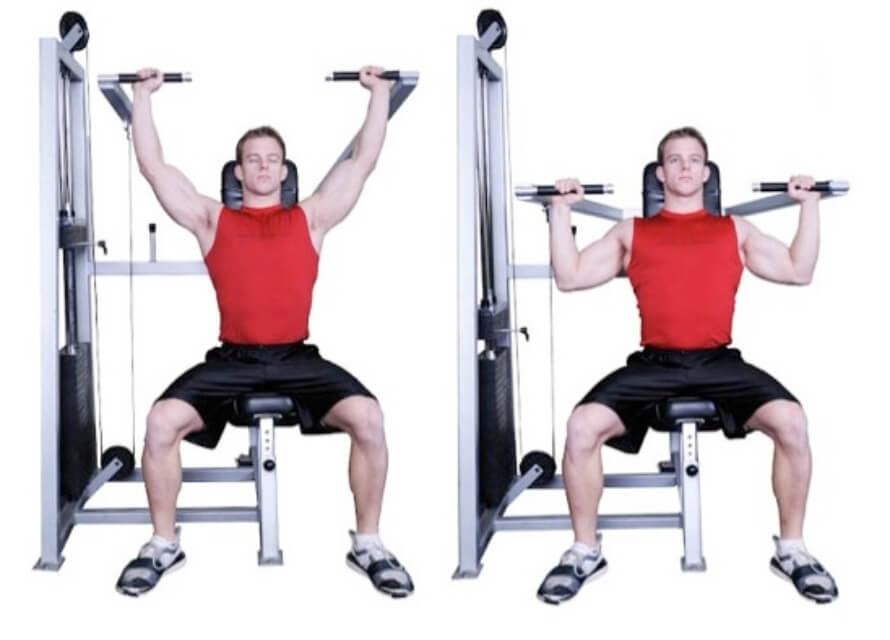
Why: Generally speaking, machines aren’t as effective as free weights. However, the machine shoulder press can be useful if you’re working around an injury or if you’re new to weightlifting.
How to:
- Sit in the shoulder press machine seat with your back against the backrest and your feet planted on the floor, then adjust the seat’s height so that the handles are about the same height as your ears.
- Grip the handles with your palms facing away from you, then press them toward the ceiling until your arms are straight.
- Reverse the movement and return to the starting position.
5. Landmine Shoulder Press
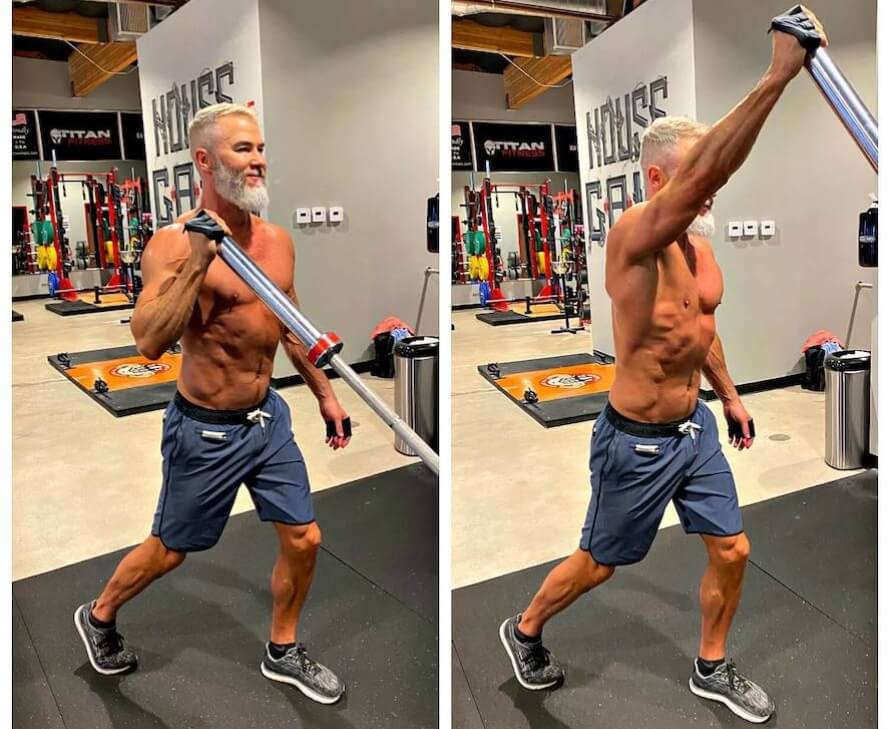
Why: The landmine shoulder press trains just one side of your body at a time, so it’s useful for identifying and correcting any strength or muscle imbalances you might have. The diagonal pressing path also makes it more comfortable for some people with shoulder issues.
How to:
- Place one end of an empty barbell in a landmine attachment or wedge it into the corner of the room and load the other end with weight plates.
- While facing the weighted end of the barbell, use both hands to hoist the barbell up to chest height.
- Move the barbell in front of your right shoulder, then take your left hand off of the bar and let it hang at your side.
- Stagger your stance by moving your right foot slightly behind your left.
- Brace your core and press the barbell away from your shoulder until your right arm is straight, then reverse the movement and return to the starting position.
- Once you’ve completed the desired number of reps, switch sides and repeat the process with your left arm.
If you enjoyed this article, get weekly updates. It’s free.
Sending…
Great! You’re subscribed.
100% Privacy. We don’t rent or share our email lists.
